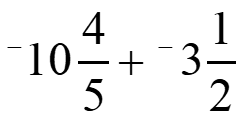abs(-4) * 5 =
20
7.824 + 23.5=
31.324
38.134 – 31.9=
6.234
60 / 5
12
The absolute value of a number is the _______ from ________ on a ____________
Bonus:
It is always _______
Distance from zero on a numberline
Bonus:
It is always positive
-5 * -5 =
25
-14 + -8
-22
- 20 - (-4) =
-16
-14/2
-7
Only when _________ rational numbers we use
__ __ __
__ __ __ stands for _____, ______, ______
When subtracting rational numbers we use KCC
KCC stands for keep, change, change.
9 * -7 =
-63

-13 13/10 or -14 3/10

-3 4/10 or -3 2/5
-634 / -4
158.5
When multiplying or dividing a positive by a positive we get a ______ signed number.
When multiplying or dividing a negative by a negative we get a _______ signed number.
When multiplying or dividing a positive by a negative we get a _______ signed number.
When multiplying or dividing a negative by a positive we get a ________ signed number.
positive
positive
negative
negative
When multiplying the same signs together, the answer will be a positive signed number
When multiplying different signs together, the answer will be a negative signed number.
-79.3 * 3 =
-237.9
–33 + 91
58
–3.37 – 9.668
-13.038
632.44/-5
-126.488
When adding two numbers of different signs we _______ the number with the smaller _____________ from the number with the bigger _____________.
We then take the sign of the number with the bigger _______, and give that sign to the answer, or the ________ between the two numbers.
We subtract the number with the smaller absolute value from the number with the bigger absolute value.
We then take the sign of the number with the bigger absolute value and give that sign to the answer, or the difference between the two numbers.
-634 * -5.4 =
3423.6
–16 + –25
-31

5 7/6 or 6 1/6
-5/6 divide 1/3
-15/6 or -2 3/6 or -2 1/2
When dividing fractions we _____ the second fraction so that the ______ is on top and the ______ is on the bottom.
We call the second fraction a _________.
We then _______ the top numbers straight across, and _______ the _______ numbers __________.
Flip the second fraction so that the denominator is on top and the number is on the bottom.
The second fraction is called a reciprocal.
Then, we multiply the top numbers straight across and multiply the bottom numbers straight across.